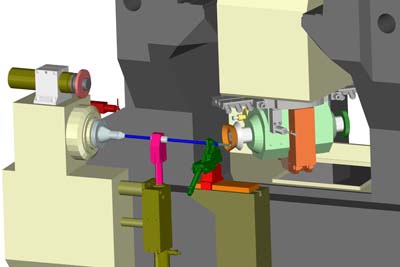
NUM is extending the power of its world-leading tool grinding software package, NUMROTO, with enhanced collision detection and other new features. NUMROTO is programming software for producing and resharpening special-purpose tools, and is used in over 2,500 machines worldwide. In the new 3.5.1 version of the software, NUM is enhancing the collision detection capability of the simulation tool. Users can now create machine models that will accurately account for all of the add-on and moveable parts of a machine such as supports, tailstocks, steady rests and special chucks. This new feature allows exhaustive simulations to be carried out on new tool grinding programs and helps grinding machine manufacturers to engineer more compact machines.
Among numerous other notable new features in NUMROTO 3.5.1 is enhanced protection against grinding wheel overloads, achieved by means of continuous high-precision monitoring of removal rates. This feature automatically flags even the shortest-duration overloads, and can also be used to optimize feed rates and operation cycle times.
Applications such as grinding form cutters will be helped by another new feature.
NUMROTO can now import compensation profiles that have been generated by an external measuring machine, to control subsequent grinding operations that produce the tool's final form.
NUMROTO 3.5.1 also extends the capability of its in-process measurement feature for more grinding operations. Support for several new measurements, especially ones that aid the machining of inserts, are added.
A final notable feature is improved support for tool grinding operators that employ custom code sequences for special purposes.
NUMROTO will now integrate and simulate proprietary ISO CNC programs in 3-D.
Related Glossary Terms
- 3-D
3-D
Way of displaying real-world objects in a natural way by showing depth, height and width. This system uses the X, Y and Z axes.
- computer numerical control ( CNC)
computer numerical control ( CNC)
Microprocessor-based controller dedicated to a machine tool that permits the creation or modification of parts. Programmed numerical control activates the machine’s servos and spindle drives and controls the various machining operations. See DNC, direct numerical control; NC, numerical control.
- feed
feed
Rate of change of position of the tool as a whole, relative to the workpiece while cutting.
- grinding
grinding
Machining operation in which material is removed from the workpiece by a powered abrasive wheel, stone, belt, paste, sheet, compound, slurry, etc. Takes various forms: surface grinding (creates flat and/or squared surfaces); cylindrical grinding (for external cylindrical and tapered shapes, fillets, undercuts, etc.); centerless grinding; chamfering; thread and form grinding; tool and cutter grinding; offhand grinding; lapping and polishing (grinding with extremely fine grits to create ultrasmooth surfaces); honing; and disc grinding.
- grinding machine
grinding machine
Powers a grinding wheel or other abrasive tool for the purpose of removing metal and finishing workpieces to close tolerances. Provides smooth, square, parallel and accurate workpiece surfaces. When ultrasmooth surfaces and finishes on the order of microns are required, lapping and honing machines (precision grinders that run abrasives with extremely fine, uniform grits) are used. In its “finishing” role, the grinder is perhaps the most widely used machine tool. Various styles are available: bench and pedestal grinders for sharpening lathe bits and drills; surface grinders for producing square, parallel, smooth and accurate parts; cylindrical and centerless grinders; center-hole grinders; form grinders; facemill and endmill grinders; gear-cutting grinders; jig grinders; abrasive belt (backstand, swing-frame, belt-roll) grinders; tool and cutter grinders for sharpening and resharpening cutting tools; carbide grinders; hand-held die grinders; and abrasive cutoff saws.
- grinding wheel
grinding wheel
Wheel formed from abrasive material mixed in a suitable matrix. Takes a variety of shapes but falls into two basic categories: one that cuts on its periphery, as in reciprocating grinding, and one that cuts on its side or face, as in tool and cutter grinding.
